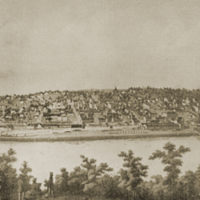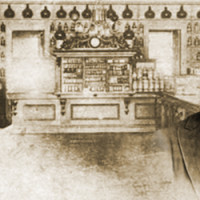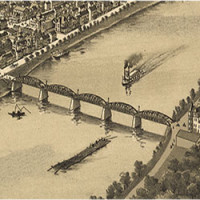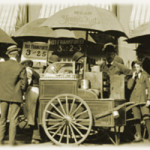
The enigmatic Beck’s Public Baths token has been a numismatic mystery since the latter part of the 19th century. With its lone obverse device depicting a woman bathing, the only aspect of the token which exceeds the token’s mystery is the beauty of the woman herself. The reverse of the token doesn’t reveal many clues about the token as well. The reverse features the business’ name, two florettes, and its premised city of issue.
However, only a scant bit of evidence to date has emerged that incontrovertibly and inexorably links the token to Richmond, Virginia. The existence of records dating to the Hard Times Era are few, after many public documents were burned during the Civil War.
David Schenkman, author of Virginia Tokens, briefly explored the Beck’s token in the May 1980 edition of The Numismatist. In his essay, he writes that several entries for “Beck’s Public Baths” was uncovered in two Richmond Virginia Deed books.
The first deed entry dated from 1832, and the second was dated from 1844. Both entries listed the owner as Charles Beck, as well as indicated its location on the south side of Main Street between 13th and 14th streets. Along with running a public baths, Charles Beck was also a confectioner.

Russel Rulau, in his Standard Catalog of United States Tokens Fourth Edition, estimates that Beck’s business operated from 1832 through 1844.
Nevertheless, it seems possible that both Schenkman’s and Rulau’s estimates may be inaccurate or incomplete.
Over the last year, more substantial research has been undertaken by this author. Additional documents were discovered and examined, as well as supplemental business advertisements that may call into question the 1844 date.
Fire insurance policies, originating from the Mutual Assurance Society, validate both the existence and the location of Beck’s businesses, as well as confirm most of what Schenkman and Rulau report. Contained within the policies were building maps and the street location, as well as affirmation that not only did Charles Beck operate a public bath facility, but was also a confectioner.


However, what was most suprising from this new research was the discovery that the Beck’s Public Baths businesses may have continued to operate for several years after 1844.
Of the insurance documents discovered, one dating from 1851 was also found. Like the earlier policies, the Public Baths property had remained insured. (Policies from 1836, 1844, and 1851 were located.)


What is uncertain, however, is whether Charles Beck himself continued to operate the businesses, or his son took over the enterprise sometime in the 1840s. Census documents from the era confirm the residencies of both Charles Beck Sr. and a son, Charles Beck Jr — both of Henrico.
Charles Beck Sr. was born in 1781, and died on June 22, 1848.
His son, Charles Jr., was born in 1823, and continued to appear in both the 1850 and 1860 U.S. censuses.
Thus, if the business had remained open up until 1851, as the fire insurance documents appear to confirm, it would have been his son who continued the operations. Indeed, looking closely at the 1851 document, it appears that the “JR” suffix is noted after the Charles Beck name.
Numismatic Specimens
Three varieties of the Beck’s Public Bath tokens are known. The more common variety, struck in copper, is cataloged by Rulau as HT-441, and has an estimated rarity rating of R-3.
The second variety, struck in German silver, is quite rare, and is cataloged by Rulau as HT-441A. It’s rarity rating is R-8.
Likewise, the third variety struck in white metal, and is cataloged as HT-441B. It is equally rare.
As to the token’s beautiful design, in 1999 numismatist Wesley Cox researched and through die analysis demonstrated that Beck’s tokens were produced by the firm of James Bale of New York. Given the uncertainty of exactly when its dies were cut, its design may have also involved engravers Charles Cushing Wright, or Frederick B. Smith.
All varieties, when they are seldom encountered, are most often found in lower grades. Given this, it is surmised that the tokens were heavily used by the Richmond public.
Higher grades exceeding VF-20 in grade are much more difficult to find. Collectors may spend years searching for Extra Fine and higher grades. When they do find one, they most often discover that such grades command stratospheric prices.

Below is a HT-441, struck in copper and in AU grade.
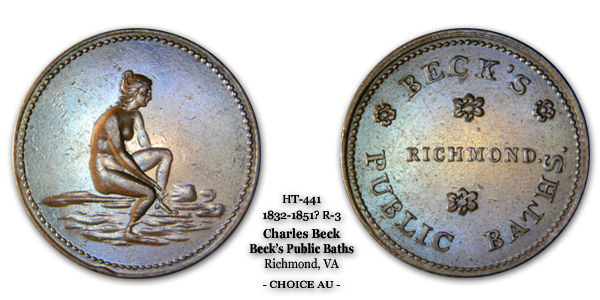
Aaron Packard ![]()
Notes and Sources
† Image courtesy of The Library of Congress
-
Standard Catalog of United States Tokens 1700-1900 Fourth Edition, Russell Rulau, Krause Publications, ©2004
-
The Numismatist, May 1980, ‘Beck’s Public Baths,’ David Schenkman
-
Virginia Tokens, David Schenkman, The Virginia Numismatic Association, ©1980
-
The City of Richmond Archives, Mutual Assurance Policies
-
The Southern Literary Messenger, Volume 9, B.B. Minor, 1843
-
Find A Grave, Record No. 5013383
-
The United States Censuses, 1830, 1840, 1850, 1860
-
100 Greatest American Medals and Tokens 1st Edition, Jaeger & Bowers, Whitman, ©2007
-
The Virginia Historical Society, Richmond Virgina
-
The Library of Congress Digital Archives
- New York’s Crystal Palace & The H.B. West Tokens - November 6, 2019
- Edward Aschermann’s Cigar & Tobacco Tokens - November 2, 2019
- George T. Hussey & His Special Message Tokens - October 30, 2019

